Alright, I’ve been avoiding writing this post because it’s going to be some tough love. But I was just at IlluXcon this past weekend, and I had a few good conversations that came up around this topic, so I want to get it down in words so more folks can see it. And if doing portfolio reviews for 20 years has taught me anything, it’s that if a topic comes up over and over again, it’s in the zeitgeist and a lot more people are dealing with it and/or need to think about it. Here we go…
Most of my posts — and my portfolio reviews — focus on that getting that first big job. When you haven’t gotten that first legit pro job yet, it feels like it’ll be the key to everything. If you can just get that Magic card, or book cover, you’ll be set, your career will be off to the races, and you’ll be set. And looking from the outside, we see artists “break through” all the time, right? Someone might be kicking around the scene for a bit, and then suddenly it feels like they have 10 jobs come out at once. And then they’re off to a healthy career. That’s why many of my posts on Muddy Colors are about contacting ADs, getting your work out there, industry ladders to climb, etc. It’s about getting your foot firmly in the door. And to be honest, this “break through” or “break out” moment is kind of a myth I need to write an article on one of these months — the saying is “it takes 10 years to be an overnight success” and while I don’t think it’s necessarily a full 10 years, there definitely is no such thing as an overnight success. But let’s put that part aside for now. Let’s work with the idea of the break through job in its mythic form. An artist gets that first big job and suddenly everyone is hiring them and they never have to look for work again.
Does this happen? Yes, totally. But it’s not automatic. At some point an artist is going to get a big break. It could look like a more experienced artist recommending you. It could be that another artist ghosted a job or had to leave a series midway and your style is similar. It could be that you did a cool personal piece that caught an AD or editor or author’s eye. You might have had a great portfolio review and impressed an AD and they take a chance on you. You might have been in a gallery show the right person might have gone to. You could have sent your cold call email to an AD at the exact time they needed someone that looked like you. All of these scenarios have happened, specifically, to me, and while I don’t want to tell people’s origin stories without their permission, but we’re talking artists like Tommy Arnold, Martina Fačková, Eleonor Piteira — artists that SEEMED to have come out of nowhere and gone from trying to get their first job to immediately overbooked and had a ton of pieces come out all at once. I am sure those artists would agree that there was never a point that felt like a singular breakout moment to them, but that’s how it looks from the outside.
But this doesn’t happen to everyone. And the REASONS it doesn’t are what I want to write about today. Tough love time. I’m going to be very general here, because obviously I’m not going to name names, but just know that I’ve dealt with all these examples personally AND 100% of Art Directors I’ve discussed these things with will agree with me on these. In fact, I can guarantee we talked about it the last time we saw each other at that event we were all just at…
The truth is, it’s not the first big job that makes you, it’s the second and third.
As I’ve said on this site before and in an infinite number of portfolio reviews, Art Direction is risk management. You have to constantly take on new artists, but you’re trying to minimize the chance that they’re going to sh*t the bed on your job. ADs are constantly scanning for info on artists they want to work with for the first time — what’s the weakest piece in their portfolio? Do they have a real website? Do they seem like a professional on social media? Have they worked with any other ADs you know? Have they mentored or been taught by any artists you know? At some point the readiness score crosses a threshold in your mind and you’re ready to take a chance on them when the right project comes up. And then it does. And if you’re the first AD to give them a shot, or if it’s a big jump in size of job they’ve ever had before, this could be their break through piece. And everyone wants that. You all do your best to get the best portfolio piece & successfully approved job that hopefully sells a lot of whatever you’re trying to sell.
If the job goes well then you’re going to be happy to give them more work (as most work in SFF comes in series or sets) and simultaneously you’re going to gossip about it to all your other AD friends. There is NO better door-opener than one AD saying to another, omg this artist did such a great job for me and they were so great to work with. I’ve seen an artist get snapped up by multiple ADs simultaneously after an email like that. So remember, a lot of work is on different launch timelines, so an artist can be steadily working on 3-5 big jobs over a year or more and then have them go public kind of all at the same time. It LOOKS like this artist came out of nowhere.
This doesn’t mean if your first job doesn’t go perfectly you’re sunk. There are a LOT of reasons a job can go south, and many of them have nothing to do with the artist. Approvers will inexplicably hate something, a project will get cancelled, an author won’t deliver a manuscript for years overdue. But ADs don’t hold that against the artist. In fact, an email from an AD that says “this was an awful job and the artist stuck with it and did their best in the situation” is an even MORE valuable recommendation to an AD.
However, there are also too many times working with an artist goes from “omg so excited to try them out” to “probably never working with this person again after this” and sometimes that IS the artist’s fault. And you can see this happening from the outside when an artist will do a job for a few different places, but never more than once for the same company, and then they stop putting out work entirely. It’s not that they were blacklisted in any way — trust me, ADs talk about good experiences with artists much more frequently than bad ones — but the artist never gets momentum, because they do one job with an AD and then they’re done there, then maybe another AD and they’re done there too. If you’re never rehired, you run out of ADs that need your style pretty quickly.
So here’s some things that get an artist on a “not working with again” list for an AD:
Work of significantly lower quality than in your portfolio:
We see this a lot when an artist jumps from personal work to client work for the first time. Happens a lot with artists that have huge followings on instagram but not enough commercial work. Self-assigning work naturally means playing to your strengths, and that’s totally understandable, but not being able to deliver on quality of work when details are provided to you is common. And I don’t mean “I’m a character artist and they asked for a landscape” — that’s the fault of an inexperienced AD — I mean someone can’t do male characters to the same quality as female characters, or they can’t get anatomy right in in a pose or just can’t hit the same level of quality on demand or for a deadline. If your portfolio is great, but you’ve been around a long time and there’s still no client work in there — that’s a red flag.
Refusal or inability to revise:
A commissioned pro job is a collaboration. Maybe when you’re a Famous Artist you will be given carte blanche to make up most of the details (see Daniel Dociu‘s book covers for James S. A. Corey) where the approvers mostly stay out of your way, but usually you are given pretty set parameters. This [character] doing [action] in this [background] looking [emotion]. A landscape of [scene] that feels [emotion] from this [camera angle]. It’s your job as an artist to come up with visual solutions to that. And there’s going to be revises along the way. That’s just part of the process. Sometimes revisions get out of hand because of approver issues, and an AD won’t hold the artist accountable for people on their side being nitpicky. If things go on for too many revisions you absolutely can ask for more money. But there’s a healthy amount of revision that’s standard, and this is where a lot of artist’s shoot themselves in the foot. Are you expected to make every change asked for ad infinitum? Of course not. Do you have to do everything a client asks for like a mindless service provider? Absolutely not. But this is a collaboration. Not a fine art piece. And there’s a commercial purpose beyond making a beautiful portfolio piece. And sometimes the art suffers a little because of that. In my world, book covers need to be successful advertising first and gorgeous works of art second, no matter how much that pains us.
There’s two paths that will get you on the do not hire list ASAP: making revisions in teeny indetectable steps (passive aggression is always a bad look) or refusing to make the changes at all. If you think a revise is dumb, you absolutely can and should offer an alternative solution (and extra credit if you do and it’s accepted) but sometimes you just have to do it to get the piece approved. Get the job done like a professional. Know that the AD is probably in as much or more pain than you are over it. Put whatever version of it you want in your portfolio.
This is a big opportunity for that above-mentioned golden recommendation: “the process was a pain but the artist was a champ.”
Bad Communication
Look, everyone is stressed. The world is on fire all the time and the robots are coming for us all. That said, do not go AWOL. At no point should the AD have to wonder if an email got lost. Again, no one is saying you have to answer emails within the hour, and we know a lot of folks work in different time zones, but if something goes unanswered for 48 hours or more on a weekday without a heads up that you’re away then we worry. I’m not saying you have to have the work or revision done in 48 hours. I just mean a sign that you received it.
This is especially egregious if we can see you posting on social media at the same time you are not responding to our emails for days on end.
And except in the case of legit technological fail or health crisis or family emergency (and you only get one or two of those per AD per career) we should not have to chase you on social media DM to see if you are still working on the job. I can rattle off a few names of artists that have done this to multiple ADs over the years and ghosting a job IS the one sure way to get people talking about you in a bad way. If you go complete incommunicado mid-job to the point that an AD has to hire someone else to do the job and wonder if you’re going to pop up weeks or months later? Yea, they’re warning every friend in the biz they know. In fact, certain incredible artists I will not specifically name have turned a job save like this into a career-making win. More than one. You know who you are, and bless you. We never forget the artists that save our asses.
Also, while we’re on the topic, some not-necessarily-dont-hire-again-but-very-annoying communication problems are folks that don’t maintain an email chain for a job (do you know how scary our inboxes are? Make our lives easier and stop starting fresh chains for every reply) and even more annoying are folks that never keep the CC’s included on the email chain. Absolute chaos. They’re CC’ed FOR A REASON!
Deadline Blindness
Look, we all miss deadlines sometimes. But do you ALWAYS miss deadlines? Do you consistently take on more work than you can realistically handle? Do you miss that deadline by days or is it weeks? Do you blow the deadline without saying anything and hope that the AD doesn’t email you looking for it?
Some of this also falls under the Bad Communication category, but you should email the client as soon as you know missing the deadline is possible and especially as it crosses over into likely. Better to email just in case then hit the deadline after all, than blow the deadline and have the AD have to send a chase email. It’s good to check in and see how firm the deadline actually is with an offer of “I can get it to you on time if that deadline is firm, but I can do more with a little more time”. But not on every job, please. You can counter-balance by delivering early every once in a while. Also, note that one of the best easiest ways to impress a client you’re working with for the first time is to DELIVER EARLY. I don’t know why this isn’t more common practice, but it’s a true cheat code to deliver a day or two before deadline. It’s so rare it’s absolutely memorable. when you get a deadline, just shave a day or two off in your calendar and let me tell you, what a great first impression!
Remember that it’s more than ok to negotiate the schedule when you are offered a job. Sometimes there’s more room, sometimes there’s not, but being honest about your schedule always looks good. You can absolutely respond, “hi, I absolutely want to take this job, is that a hard deadline or is there a little wiggle room?” “Can I deliver it on X?” “Can I send sketches by X but have a little more time for final”, etc, etc.
Paperwork & Payment Drama
Look it’s rare that paperwork is the reason we don’t hire someone but it does often breed chaos and make everything harder. Every company has different systems about paperwork and payment. Follow directions. If you don’t understand something, ask. Remember that the bigger the company, the harder the paperwork generally is, and the less helpful Accounting will be. Some companies will have you talk directly to Accounting, some will have everything go thru the AD or a Studio Manager in the Art Department, but either way fill out everything carefully, and if you don’t understand something, ask questions.
Seriously like half the payment problems we have are artists filling out paperwork wrong and needing multiple tries to get it right. It makes a ton of delays, because generally the Art Dept thinks the paperwork is fine and then it’s days or weeks later they hear they need a revise and then they have to get back to you and then every time revised paperwork is submitted it resets the clock with Accounting again. I’d say in the realm of Payment Problems 80% is on the artists and only 20% is on accounting. Sorry guys, most of you suck at paperwork.
The one time that payment problems do lead to not being rehired really falls under the next category, but it’s when the ball is in your court (missing invoice, paperwork, your bank info is wrong, they don’t take the currency or transfers you think they do, etc) and you send a nasty email about not being paid and we go back and it’s on you. Always feel free to send questions and follow-ups. Paperwork and accounting is hard. We’re artists, we’re bad at math! But starting off from a nasty place is burning bridges you don’t need to burn.
Being a Jerk
I mean, this seems like it should go without saying, but yelling at a client, flaming an AD or company online, or—I hate to say this but it has happened—being sexually inappropriate or harassing and AD or client is the other way to Never Work In This Town Again. Are some clients shitty? Sadly, yes. There’s bad clients and bad ADs. But there’s a difference between a tough job where everything goes wrong and an abusive one. Stay professional, always. Even if you are stopping a job in the middle. Even if you get to the point that you have to invoke the name of your lawyer (especially then, trust me, the lawyers agree with me), you have to stay professional. Maybe the client deserves to get flamed online. You can make a public statement. But stay professional doing it. People looking in from the outside can tell the difference between someone warning people about a bad situation publicly but professionally vs. shit-posting & flaming. You might not care about working with that client again, but what about all the clients seeing it that don’t know the true story. Even if they give you the benefit of the doubt, they will still be wary of how you handled it.
—
Ok, I’m sure there’s more but that’s enough for now. I’ve got all the big ones I think. Remember the Venn diagram! Good, Nice, On Time. If you are 2 of 3 there will always be work to find. If you are 3 out of 3, the work will find YOU.
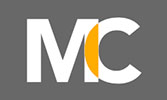
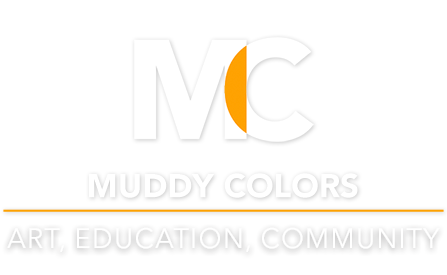
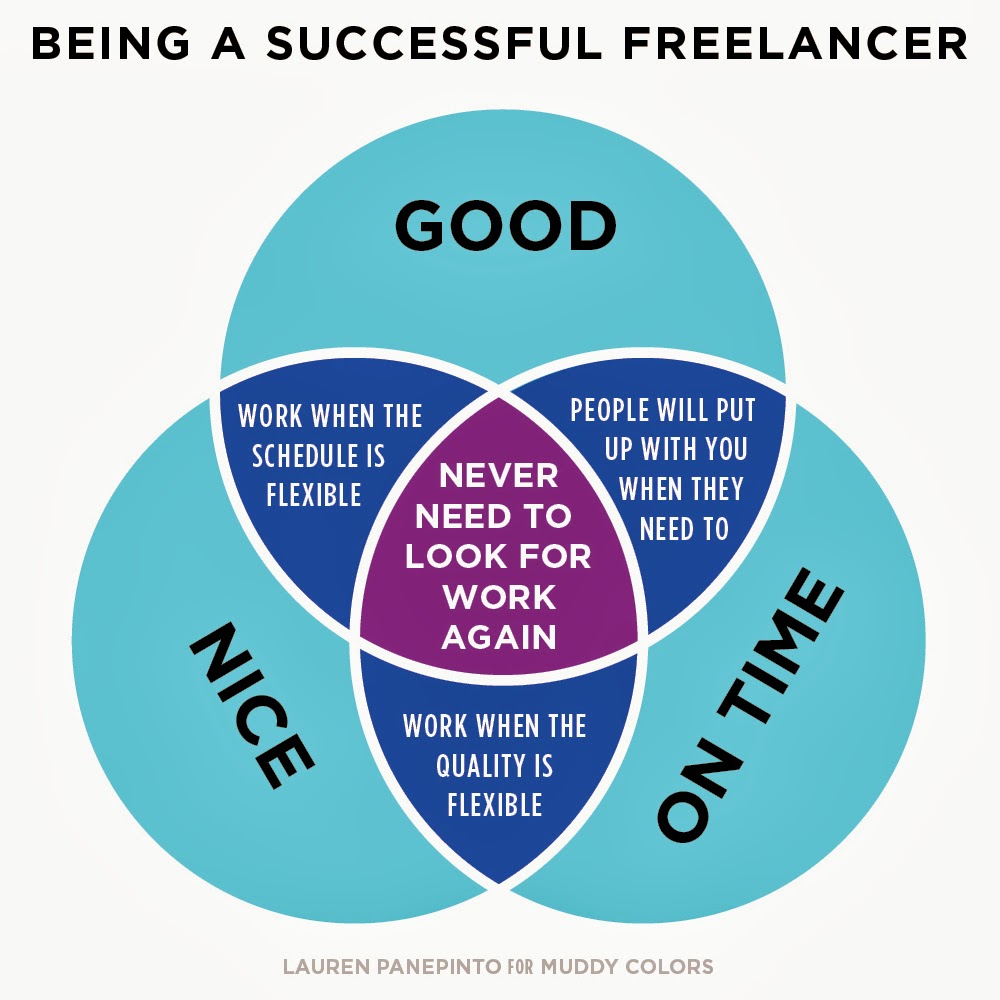
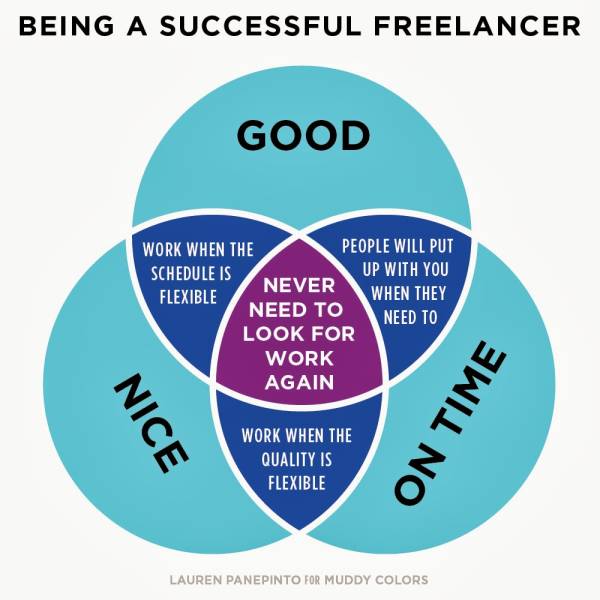

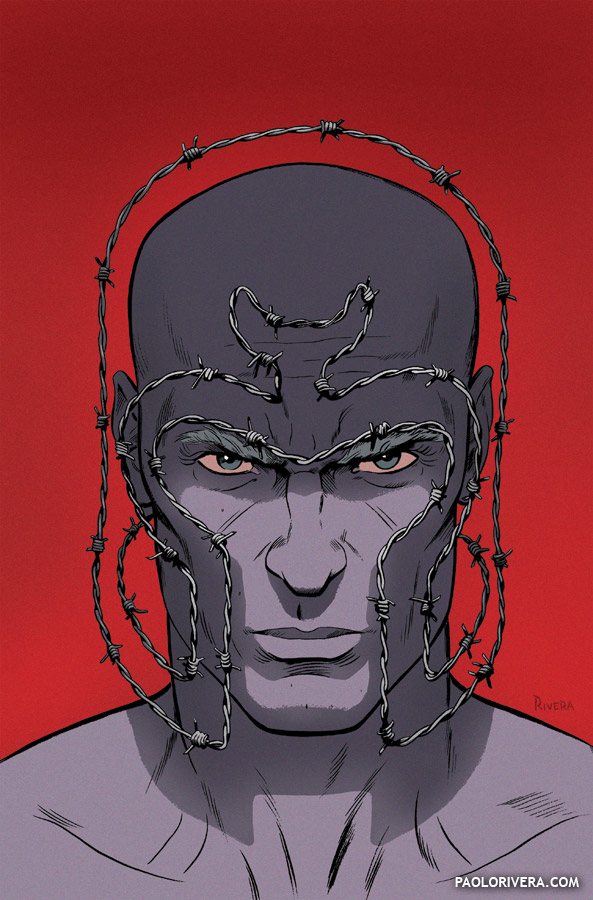
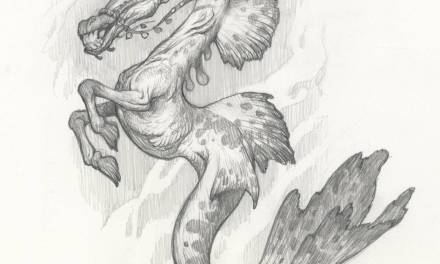

Really appreciate you tough-loving us, Lauren. Thank you for this wisdom!
I hope it helps! Hate to see someone finally getting that big opportunity and then wondering why folks aren’t calling them back
“At no point should the AD have to wonder if an email got lost.” — Does this apply the other way, too? Or is it just the artist that needs to respond in a timely manner? I’m asking because I got offered a job from a big publisher, got the brief, signed the paperwork, and never heard back from them again. I sent my sketches, sent a follow-up email when I got no reply, but there was no further communication. Not even a quick “I’ll get back to you later” or “the job randomly got cancelled” or anything. Is being ghosted by an AD something we as artists just have to accept and move on with our lives? Genuine question because this is my first publisher contract so I don’t know if this is normal.